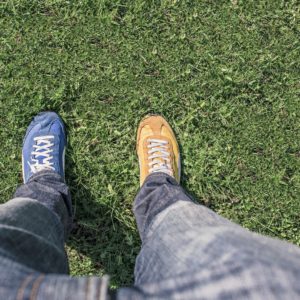Leg length discrepancy (LLD) is a controversial topic in healthcare, with some therapists attributing virtually all pain problems to it and others saying it does not matter at all. In this blog, we will explore the evidence behind LLD.
How do you measure and identify LLD?
The gold standard for measuring LLD is radiographically through X-rays, CT scans or MRIs. It must be noted, however, that even these imaging methods involve a degree of subjectivity as to where the measurement markers are placed.
Clinically, the most commonly used method involves measuring the distance between bony landmarks at the hip and ankle. This method has been shown to have good reliability and accuracy at detecting differences greater than 1cm, compared to a CT scanogram. It must be noted, however, that these measurements are all prone to human error.
How common is LLD?
LLD is extremely common, having been found to affect 90% of the general population, with the average difference being approximately 5mm (Knutson, 2005). The more difficult question to answer, however, is: when does LLD become a significant contributor to someone’s pain?
When does LLD cause issues?
The evidence suggests that, for most people, anatomic leg-length inequality does not appear to be clinically significant until the magnitude reaches approximately 2cm. LLD is thought to contribute to pain and pathology through excessive ground reaction forces, as the shorter limb has to travel further to reach the ground. These excessive forces are thought to lead to pain and pathology through overloading muscles, ligaments, tendons and joints of the lower limb, pelvis and spine.
The literature exploring whether LLD causes musculoskeletal pain is contradictory and inconclusive. A large prospective study of over 3000 individuals showed that LLD greater than 1cm was associated with an increased prevalence of knee joint osteoarthritis. However, there are many papers showing no correlation between LLD and chronic lower back pain (Hoikka et al. 1989) or running injury in recreational runners (Hespanhol Junior et al. 2016).
Whether or not LLD is contributing to your symptoms is a complex question, as a range of factors could be contributing to your pain. LLD may be the cause of certain overload conditions, and a thorough assessment will be needed to determine this.
If you think you have LLD that is contributing to your pain, please call us on (02) 9232 5566 or click here to schedule a consultation with one of our Bend + Mend Sports Physios in Sydney’s CBD.
Hespanhol Junior LC, de Carvalho AC, Costa LO, Lopes AD. Lower limb alignment characteristics are not associated with running injuries in runners: Prospective cohort study. Eur J Sport Sci. 2016 Nov;16(8):1137-44.
Hoikka V, Ylikoski M, Tallroth K. Leg-length inequality has poor correlation with lumbar scoliosis. A radiological study of 100 patients with chronic low-back pain. Arch Orthop Trauma Surg. 1989;108(3):173-5.
Knutson GA. Anatomic and functional leg-length inequality: A review and recommendation for clinical decision-making. Part I, anatomic leg-length inequality: Prevalence, magnitude, effects and clinical significance. Chiropr Osteopat. 2005;13:11.






